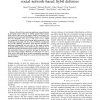Free Online Productivity Tools
i2Speak
i2Symbol
i2OCR
iTex2Img
iWeb2Print
iWeb2Shot
i2Type
iPdf2Split
iPdf2Merge
i2Bopomofo
i2Arabic
i2Style
i2Image
i2PDF
iLatex2Rtf
Sci2ools
119
click to vote
COMSNETS
2012
2012
Exploring the design space of social network-based Sybil defenses
—Recently, there has been significant research interest in leveraging social networks to defend against Sybil attacks. While much of this work may appear similar at first glance, existing social network-based Sybil defense schemes can be divided into two categories: Sybil detection and Sybil tolerance. These two categories of systems both leverage global properties of the underlying social graph, but they rely on different assumptions and provide different guarantees: Sybil detection schemes are application-independent and rely only on the graph structure to identify Sybil identities, while Sybil tolerance schemes rely on application-specific information and leverage the graph structure and transaction history to bound the leverage an attacker can gain from using multiple identities. In this paper, we take a closer look at the design goals, models, assumptions, guarantees, and limitations of both categories of social network-based Sybil defense systems.
| Added | 20 Apr 2012 |
| Updated | 20 Apr 2012 |
| Type | Journal |
| Year | 2012 |
| Where | COMSNETS |
| Authors | Bimal Viswanath, Mainack Mondal, Allen Clement, Peter Druschel, P. Krishna Gummadi, Alan Mislove, Ansley Post |
Comments (0)

